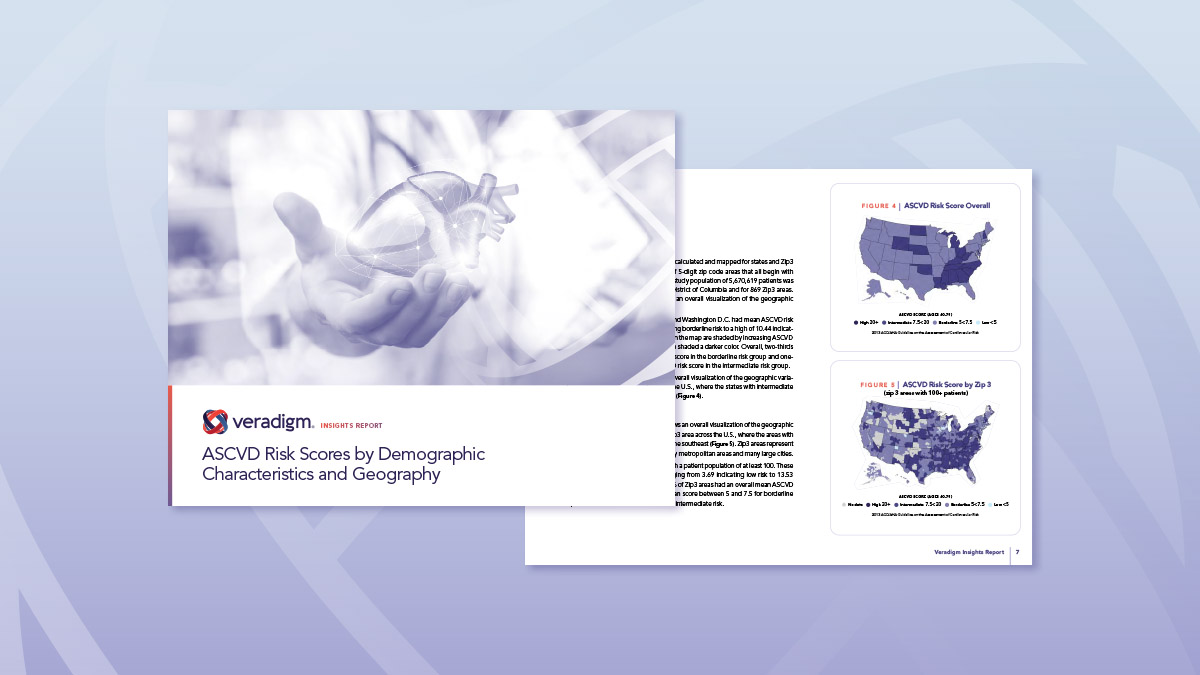Unveiling the Latest ASCVD Risk Insights: Veradigm's Comprehensive 2025 Cardiovascular Report

Written by: Katie Wilson, Veradigm
Cardiovascular disease remains the leading cause of death in the United States, with significant economic implications due to high hospitalization and mortality rates. In 2019-2020, healthcare costs related to atherosclerotic cardiovascular disease (ASCVD) amounted to $254.3 billion, making up 12% of total U.S. health expenditures1. The Veradigm Insights Report: ASCVD Risk Scores by Demographic Characteristic and Geography provides an in-depth analysis of cardiovascular health, helping you leverage this data to improve patient outcomes.
Approach
This report analyzes data from over 5.6 million cardiovascular patients within the Veradigm Network EHR (VNEHR) database, a comprehensive dataset that includes de-identified real-world data from over 154 million adult patients2. Data was drawn from physician practices across the U.S. The VNEHR database combines multiple EHR data sources within the Veradigm Network and leverages Natural Language Processing (NLP) data to present a holistic view of patient health. The report covers the prevalence of various cardiovascular risk factors and conditions, including:
- Hypertension
- Dyslipidemia/Hyperlipidemia
- Ischemic Vascular Disease (IVD)
- Arrhythmia
- Peripheral Vascular Disease (PVD)
- Atrial Fibrillation (AFIB)
- Coronary Heart/Artery Disease (CHD/CAD)
- Heart Failure (HF)
- Syncope and Collapse
- Venous Thromboembolism (VTE)
Key takeaways from the report
Cardiovascular risk factors and conditions
The report highlights the prevalence of key cardiovascular risk factors and conditions, broken down by sex, age, race, and ethnicity. Understanding these variations is paramount for developing targeted interventions and improving patient care.
Deep dive: ASCVD risk
The report provides a detailed analysis of ASCVD risk scores, examining variations by sex, age, race, and ethnicity. Geographic heat maps illustrate the distribution of ASCVD risk across the U.S., revealing regional trends and high-risk areas.
Deep dive: heart failure
Heart failure data is analyzed with a focus on patient count, ejection fraction, and BNP & Pro-BNP levels. The report includes breakdowns by sex, age, race, and ethnicity, as well as geographic heat maps. Data comparisons pre- and post-NLP enhancement provide additional insights.
Leveraging advanced technology
Our advanced technology integrates structured and unstructured data using NLP to offer a comprehensive analysis. The VNEHR database includes detailed information on race, smoking status, blood pressure, cholesterol, and HDL lab results, enabling precise ASCVD risk calculation. This robust data source allows for accurate estimation and evaluation of cardiovascular disease risk, with valuable insights for healthcare professionals.
Why download the report?
You’ll gain a thorough understanding of ASCVD risk scores across different demographic groups and geographic regions. The data provided can aid in addressing health inequities, guiding strategic decisions, and improving patient outcomes.
References:
- Internal Data on File, Veradigm February 2025.
- Internal Data on File, Veradigm February 2025.